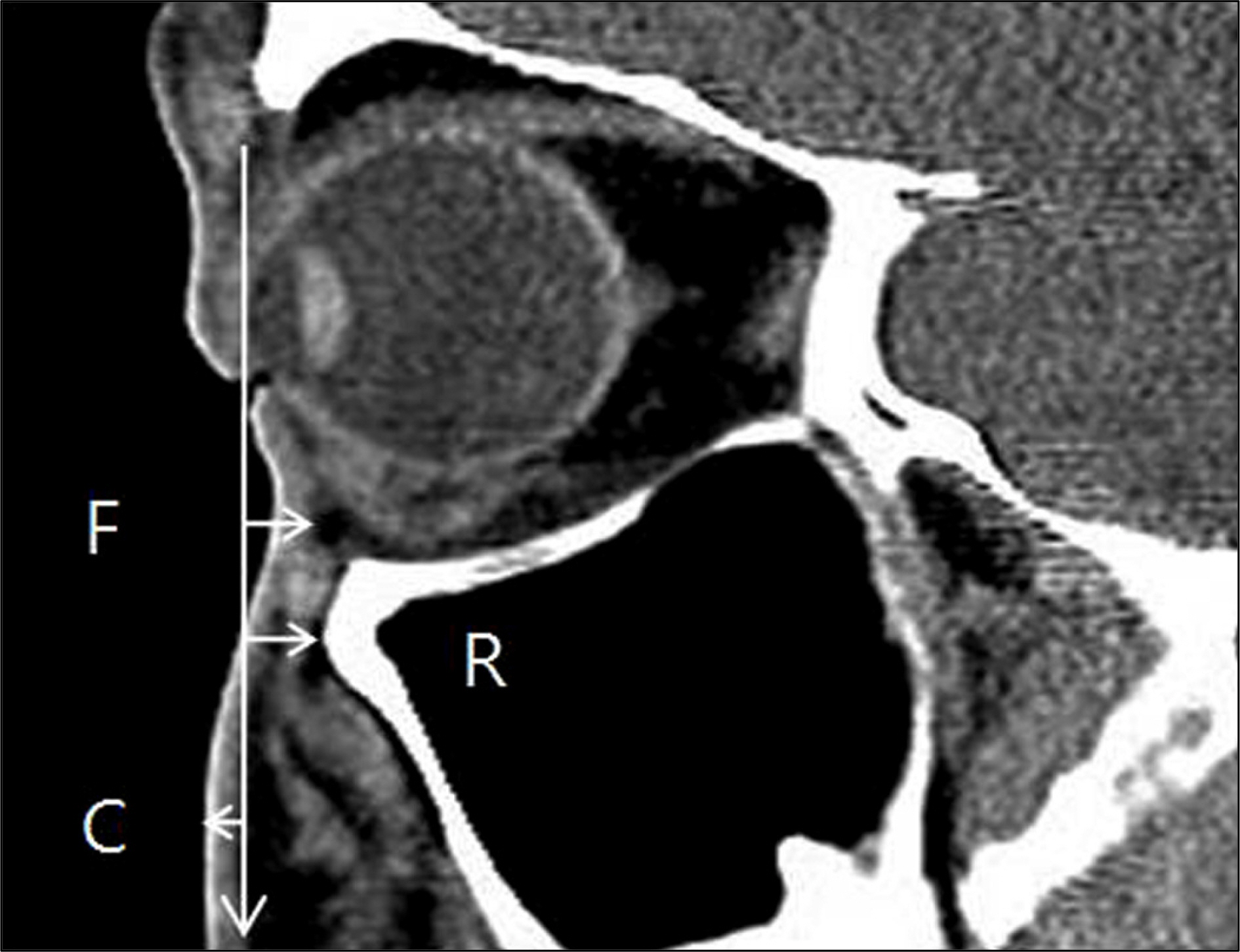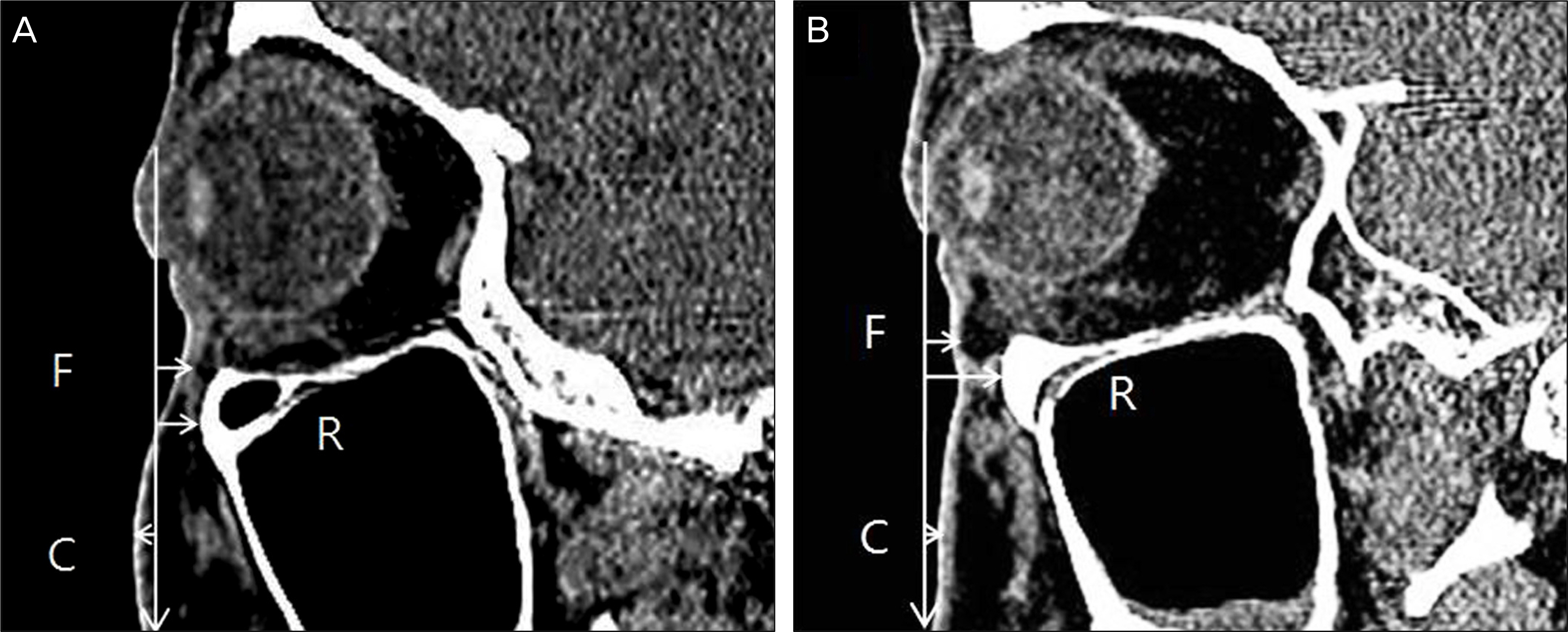J Korean Ophthalmol Soc.
2010 Nov;51(11):1427-1430. 10.3341/jkos.2010.51.11.1427.
Analysis of Age-related Changes in the Lower Lid and Soft Tissue Using Computed Tomography
- Affiliations
-
- 1Department of Ophthalmology, Dong-A University College of Medicine, Busan, Korea. hbahn@dau.ac.kr
- KMID: 2213950
- DOI: http://doi.org/10.3341/jkos.2010.51.11.1427
Abstract
- PURPOSE
The anatomic relationships of the lower lid and soft tissue between younger and older groups were compared using CT scans for confirming the negative vector relationship in the Korean population.
METHODS
The study sample was composed of 100 patients with no history of previous surgery and no ocular disease. Two groups of 100 patients, younger (less than 30 years of age) versus older (above 50 years of age), were studied using CT scans. The distances from the anterior cornea to the lower lid fat, inferior orbital rim and anterior cheek mass were measured at the midpupillary plane.
RESULTS
The mean age of the younger group was 22.0 years (ages 14 through 29), compared with 60.6 years (ages 53 thru 73) for the older group. Comparison of mean linear measurements revealed an anterior movement of the lower lid fat between younger and older groups (-5.09 mm vs. -3.50 mm, respectively, P < 0.01). A regression of the inferior orbital rim (-6.93 mm vs. -8.98 mm, P < 0.01) and anterior cheek mass (3.07 mm vs. 0.43 mm, P < 0.01) was observed with age in the sagittal cross section view.
CONCLUSIONS
The present study demonstrates the orbital remodeling according to age in the Korean population. Because the negative vector is more common in the elderly and portends a greater risk for lower lid complications after surgery, surgeons need to consider the orbital remodeling according to age before surgery.
Figure
Cited by 1 articles
-
Analysis of Upper Eyelid Fat Pad Changes with Aging and Body Mass Index in Korean
Jae Moon Ahn, Hwa Lee, Jung Wan Kim, Min Wook Jang, Tae Soo Lee, Se Hyun Baek
J Korean Ophthalmol Soc. 2013;54(4):562-567. doi: 10.3341/jkos.2013.54.4.562.
Reference
-
References
1. Bosch WA, Leenders I, Mulder P. Topographic anatomy of the eyelids, and the effects of sex and age. Br J Ophthalmol. 1999; 83:347–52.2. Pessa JE, Desvigne LD, Lambros VS, et al. Changes in ocular globe-to-orbital rim position with age: implications for aesthetic blepharoplsty of the lower eyelids. Aesthetic Plast Surg. 1999; 23:337–42.3. Richard MJ, Morris C, Deen BF, et al. Analysis of the anatomic changes of the aging facial skeleton using computer-assisted tomography. Ophthal Plast Reconstr Surg. 2009; 25:382–6.
Article4. Jelks GW, Jelks EB. Preoperative evaluation of the blepharoplasty patient. Bypassing the pitfalls. Clin Plast Surg. 1993; 20:213–23.5. Moon CS, Moon SH, Jang JW. Topographic anatomic difference of the eyelid according to age in Korean. J Korean Ophthalmol Soc. 2003; 44:1865–71.6. Levine RA, Garza JR, Wang PT, et al. Adult facial growth: applications to anesthetic surgery. Aesthetic Plast Surg. 2003; 27:265–8.7. Pessa JE, Chen Y. Curve analysis of the aging orbital aperture. Plast Reconstr Surg. 2002; 109:751–5.
Article8. Jelks GW, Jelks EB. The influence of orbital and eyelid anatomy on the palpebral aperture. Clin Plast Surg. 1991; 18:183–95.
Article9. Pessa JE. The potential role of stereolithography in the study of facial aging. Am J Orthod Dentofacial Orthop. 2001; 119:117–20.
Article10. Byrd HS, Burt JD. Achieving aesthetic balance in the brow, eyelids, and midface. Plast Reconstr Surg. 2002; 110:926–33.
Article
- Full Text Links
- Actions
-
Cited
- CITED
-
- Close
- Share
- Similar articles
-
- A Case of Acute Idiopathic Bilateral Lower lid Ectropion
- Modified Huches Procedure
- An analysis of soft tissue profile
- Surgical Correction of Lower Lid Retraction Using The Scleral Spacer
- Comparison of asymmetric degree between maxillofacial hard and soft tissue in facial asymmetric subjects using three-dimensional computed tomography



